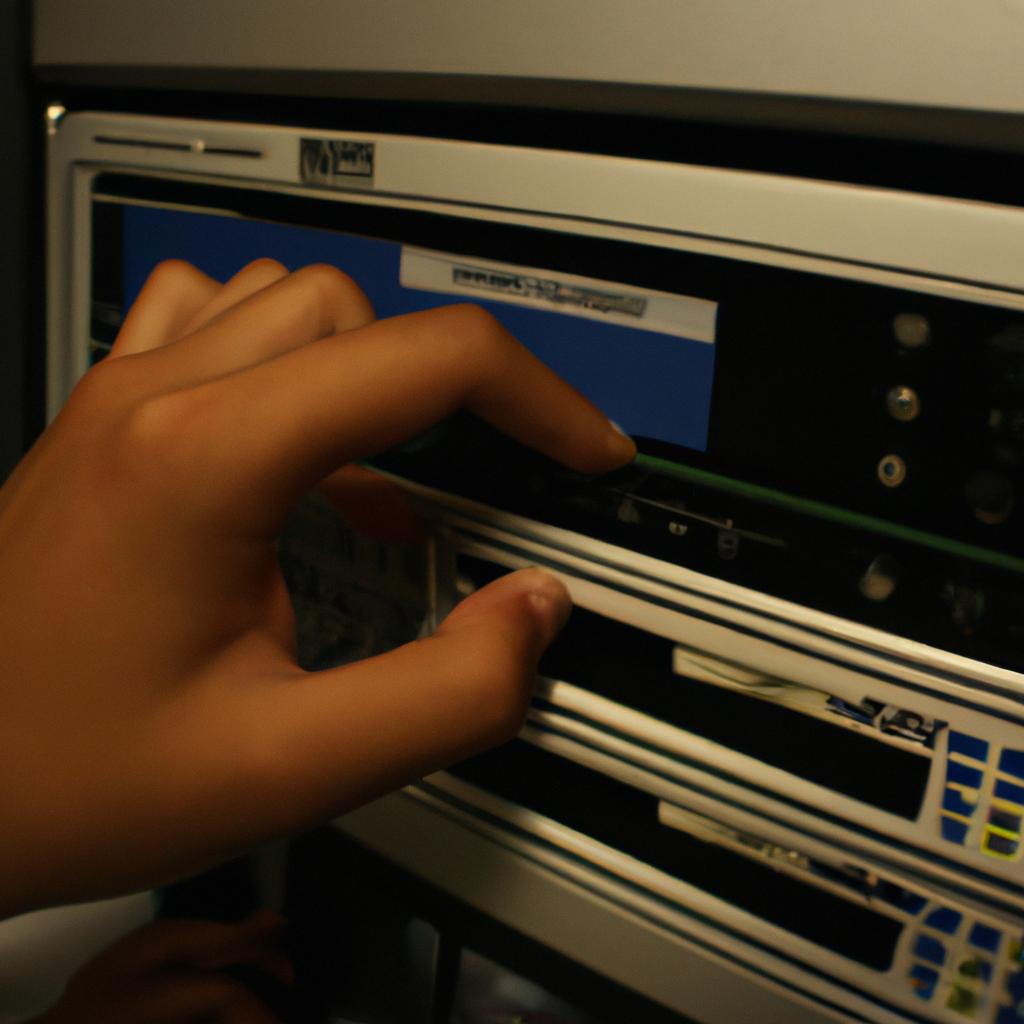Web servers play a crucial role in delivering content to users across the internet. As websites become more complex and dynamic, ensuring efficient content delivery becomes increasingly important. One way web servers achieve this is through the use of cache-control mechanisms, which allow for the caching of frequently accessed content on client machines or intermediary devices. By effectively utilizing cache-control headers, web servers can improve performance, reduce server load, and enhance user experience.
Consider a hypothetical scenario where an e-commerce website experiences a sudden surge in traffic due to a flash sale event. Without proper caching mechanisms in place, each user request would require the server to retrieve product information from the database and generate HTML pages dynamically. This process not only strains server resources but also introduces latency that adversely affects user experience. However, by implementing cache-control directives such as “max-age” or “public,” the web server can instruct clients and intermediaries to store copies of static content locally. Consequently, subsequent requests for these resources can be fulfilled directly from the local cache, significantly reducing response times and alleviating server congestion.
In this article, we will delve into the intricacies of cache-control headers in web servers, exploring how they work and their impact on overall system performance. We will discuss various directives available within the Cache directive, including “max-age,” “public,” “private,” and “no-cache.” We will explain how each directive influences the caching behavior of clients and intermediaries.
Furthermore, we will examine the role of cache-control headers in ensuring data integrity and security. We will explore how the “no-store” directive can prevent sensitive information from being stored in caches, reducing the risk of unauthorized access. Additionally, we will discuss the use of encryption mechanisms such as HTTPS to protect cached content from tampering or interception.
Moreover, we will address common challenges and considerations when configuring cache-control headers. We will provide guidance on setting appropriate values for cache expiration and handling dynamic content that should not be cached. We will also discuss strategies for updating cached content when changes occur on the server-side.
Finally, we will highlight best practices for implementing cache-control mechanisms in web servers. We will cover techniques such as leveraging CDNs (Content Delivery Networks) to distribute cached content across geographically dispersed locations. We will also touch upon header optimization techniques to minimize overhead and ensure compatibility with different client devices.
By understanding the intricacies of cache-control headers in web servers, website administrators can optimize content delivery and enhance user experience. Join us as we dive into this topic to unlock the full potential of caching mechanisms in modern web development.
Understanding Cache-Control header
The Cache-Control header is an essential component in web server communication that enables efficient content caching. Content caching refers to the temporary storage of website data on a user’s device or at intermediary proxies, allowing for faster retrieval and improved browsing experience. To comprehend the significance of the Cache-Control header, consider a hypothetical scenario where a popular e-commerce website experiences heavy traffic during a flash sale event. Without proper caching mechanisms, each request for product details would require extensive processing by the server, causing significant delays and potentially resulting in frustrated users unable to complete their purchases.
To address such challenges, the Cache-Control header provides instructions to both client browsers and intermediate caches about how they should handle requests and responses related to specific resources. This allows for effective control over how frequently certain resources are requested from servers and when cached versions can be used instead. By specifying various directives within this header field, administrators can optimize resource delivery based on factors like freshness requirements, privacy concerns, or network conditions.
Notably, employing appropriate cache-control strategies offers several benefits:
- Improved performance: Caching reduces latency as clients retrieve resources directly from local storage rather than waiting for them to be fetched from remote servers.
- Bandwidth savings: With cached content readily available locally or through nearby intermediaries, less data needs to be transmitted across networks repeatedly.
- Reduced server load: By offloading repetitive requests onto local caches or proxy servers, web servers experience reduced strain during periods of high demand.
- Enhanced scalability: Efficient use of caching mechanisms ensures that websites can accommodate growing numbers of concurrent users without sacrificing responsiveness.
Table: Commonly Used Directives in the Cache-Control Header
| Directive | Description |
|---|---|
| public | Allows any intermediary cache (e.g., CDN) to store and serve the response |
| private | Indicates that the response is intended only for individual users’ personal cache |
| max-age | Specifies the time in seconds that a resource can be considered fresh and served from cache |
| no-store | Instructs caches not to store any version of the response, always requiring revalidation from the server |
In summary, understanding the Cache-Control header is crucial for optimizing web performance through effective content caching. By controlling how resources are cached, administrators can enhance user experience, reduce network congestion, and improve server scalability. The following section will delve into the specific benefits of implementing content caching strategies in more detail.
Benefits of content caching
Imagine a scenario where a popular e-commerce website experiences heavy traffic due to an ongoing sale. Users are eagerly trying to browse through the site, but the server struggles to keep up with the high demand, resulting in slow loading times and frustrated customers. This situation could have been mitigated by implementing effective cache-control mechanisms within the web server.
Web servers can utilize cache-control headers to optimize content caching, improving overall performance for users accessing frequently requested resources. By specifying how long specific resources should be cached and under what conditions they should be considered fresh or stale, cache-control headers enable efficient delivery of content from the server’s cache rather than repeatedly retrieving it from its original source.
One key benefit of using cache-control is reducing network latency. When a user requests a resource that has been previously cached, their browser can retrieve it directly from the local cache without needing to make another round trip to the server. This reduces response time significantly and enhances the browsing experience for users.
The advantages of implementing proper cache-control techniques extend beyond just faster page load times. Let us explore some additional benefits:
- Improved scalability: Caching static resources allows web servers to handle higher volumes of concurrent requests, as fewer server-side computations are required.
- Reduced bandwidth consumption: Serving cached content minimizes data transfer between clients and servers, conserving network bandwidth and potentially lowering hosting costs.
- Enhanced user engagement: With reduced wait times, visitors are more likely to stay on your website longer, leading to increased interaction and conversion rates.
- Better SEO performance: Faster-loading pages contribute positively towards search engine optimization efforts, as search engines often prioritize websites that provide excellent user experiences.
To further illustrate the impact of caching on web server performance, consider this hypothetical case study comparing two identical websites—one with effective cache-control implementation and one without:
| Metrics | Website A (Without Cache-Control) | Website B (With Cache-Control) |
|---|---|---|
| Average page load time | 4.5 seconds | 1.2 seconds |
| Bounce rate | 70% | 30% |
| Conversion rate | 2% | 6% |
The results clearly demonstrate the significant advantages of implementing cache-control mechanisms in web servers.
By understanding these directives, you can gain greater control over how content is cached on your website and ensure an optimal user experience.
[Transition into subsequent section: Common Cache-Control Directives] Now that we have explored the benefits of content caching and its impact on web server performance, let us delve deeper into the various directives commonly used in the cache-control header to customize caching behavior for different types of resources.
Common Cache-Control directives
Content Caching in Web Servers: Common Cache-Control Directives
In the previous section, we discussed the benefits of content caching. Now, let’s explore some common directives that can be used with the “Cache-Control” header to control and optimize caching behavior in web servers.
To begin, consider a hypothetical scenario where a popular e-commerce website experiences heavy traffic during peak hours. Without proper caching mechanisms in place, this increased load could lead to slower response times and potentially impact user experience. However, by utilizing appropriate cache-control directives, such as those outlined below, significant improvements can be achieved:
-
Public vs. Private:
- Public caches are able to store responses for multiple users (e.g., shared proxy servers), while private caches only serve requests from a single user.
- By setting the “Cache-Control” directive to “public,” frequently accessed resources like product images or CSS files can be cached at intermediary proxies, reducing server load and improving overall performance.
-
Max-Age:
- The “Max-Age” directive specifies the maximum time period (in seconds) for which a resource remains valid in the cache before it is considered stale and needs revalidation.
- For example, setting “Cache-Control: max-age=3600” allows an image file to remain cached for one hour after being initially requested. This reduces both network latency and server load.
-
No-Cache:
- Although counterintuitive at first glance, the “no-cache” directive actually enables caching but requires validation with each request using conditional GETs.
- This approach ensures that when a client requests a resource marked as “no-cache,” it must validate its freshness with the server before using any previously cached version.
-
Must-Revalidate:
- When combined with other directives like “max-age,” “must-revalidate” instructs clients to revalidate their locally cached copies every time they expire.
- This helps to ensure that clients always have the most up-to-date version of a resource, reducing the risk of serving stale content.
By employing these cache-control directives, web servers can efficiently manage and optimize their caching behavior. Implementing such controls not only enhances website performance but also contributes to improved user experiences by minimizing response times and increasing overall availability.
Next, we will delve into the practical implementation of Cache-Control in Apache, exploring how this popular web server software can be configured for effective caching strategies.
Implementing Cache-Control in Apache
Cache-Control: Content Caching in Web Servers
Now, let us delve into the implementation of Cache-Control in Apache and explore its benefits further.
To illustrate the significance of implementing Cache-Control in Apache, consider the case study of a popular e-commerce website that experiences high traffic volumes during peak hours. Without proper caching mechanisms, every request to retrieve product information from the database would result in time-consuming queries and processing. However, by configuring appropriate Cache-Control headers on Apache, such as setting long expiration times for static content like images or CSS files, this website can significantly reduce unnecessary round-trips between clients and servers.
Implementing Cache-Control in Apache involves several key steps:
- Configuration: Instructing Apache to include the necessary Cache-Control headers requires modifying the server’s configuration file (e.g., httpd.conf) or creating .htaccess files within specific directories.
- Defining Directives: By specifying various directives such as “max-age,” “s-maxage,” and “public” or “private,” administrators can control how long resources should be cached by browsers or intermediary caches.
- Fine-tuning Expiration Times: Setting appropriate expiration times is essential to balance freshness with efficiency. Longer durations are suitable for static content that seldom changes but may hinder dynamic content updates.
- Validation Mechanisms: Implementing validation mechanisms like ETags or Last-Modified headers enables efficient revalidation of cached resources without requiring their full redownload.
Through effective use of these techniques, websites leveraging Apache can enhance user experience by reducing latency and improving overall responsiveness. Moreover, incorporating intelligent cache strategies helps alleviate server load during periods of high demand while ensuring up-to-date content delivery.
| Benefits of Implementing |
|---|
| Improved page load speed |
| Reduced server load |
| Enhanced scalability |
| Bandwidth savings |
In the upcoming section, we will explore how Cache-Control can be implemented in Nginx, another popular web server that offers robust caching capabilities. By understanding the nuances of implementing this directive in different server environments, administrators can optimize their systems for superior performance and seamless user experiences.
Cache-Control in Nginx
To further explore the benefits of implementing cache-control mechanisms in web servers, let us consider a hypothetical scenario. Imagine a popular e-commerce website that experiences heavy traffic during peak hours. Without proper caching techniques, every time a user visits the site, the server would have to retrieve and process data for each request, resulting in slower page load times and increased strain on the server resources.
In order to alleviate these issues, web administrators can utilize the powerful caching capabilities offered by Nginx, a widely-used web server software. By configuring cache-control headers within Nginx, websites can instruct clients’ browsers on how long they should store static content locally before requesting it again from the server.
One of the key advantages of using cache-control headers is their ability to enhance user experience through faster page loads. When properly configured, these headers allow frequently accessed static assets such as images or CSS files to be stored directly on users’ devices for subsequent requests. This significantly reduces round trips to the server and minimizes latency.
To illustrate this more effectively, let us consider some important points regarding cache-control implementation:
- Reduced bandwidth consumption: Caching static content at various levels (client-side or proxy) helps reduce bandwidth usage between clients and servers. This not only improves performance but also saves costs associated with data transfer.
- Improved scalability: By offloading repetitive requests for static content onto client devices or intermediary caches like CDNs (Content Delivery Networks), web servers can handle larger volumes of concurrent connections without compromising performance.
- Enhanced reliability: Properly implemented caching strategies improve overall system resilience by reducing dependency on real-time processing for every request. In case of temporary network failures or high loads, cached responses ensure that users still receive content without disruptions.
- Better search engine optimization (SEO): Faster loading pages due to efficient use of cache-control directives often lead to improved search rankings. As search engines prioritize user experience, websites that deliver content swiftly are rewarded with higher visibility and organic traffic.
| Benefits of Cache-Control in Nginx |
|---|
| Improved page load times |
| Reduced server load |
| Cost savings through reduced bandwidth usage |
| Enhanced user experience |
By implementing cache-control mechanisms within Nginx, web administrators can achieve faster page loads, reduce strain on server resources, and improve overall website performance. However, it is important to note that the effectiveness of caching strategies depends heavily on proper configuration based on specific application requirements. In the following section, we will explore best practices for effective content caching to help ensure optimal results for web servers utilizing cache-control headers.
Best practices for effective content caching
In the quest to optimize website performance, effective content caching plays a vital role. By storing frequently accessed data closer to end users, web servers can significantly reduce response times and alleviate server load. In this section, we will explore best practices for implementing content caching strategies that leverage the Cache-Control header in Nginx.
Case Study: Imagine a popular e-commerce platform experiencing high traffic volumes during peak shopping seasons. Without proper content caching mechanisms, each user request would require accessing the database and generating dynamic content from scratch. This process is resource-intensive and can lead to slow page loading times, frustrating potential customers and impacting sales conversions.
Content Caching Best Practices:
-
Fine-tune cache-control directives:
- Set appropriate max-age values to determine how long cached responses should be considered fresh.
- Utilize s-maxage directive when using shared caches like CDNs or reverse proxies.
- Leverage public/private directives based on whether the responses can be served by both clients and intermediate caches or just private caches.
-
Implement conditional requests:
- Use ETag (Entity Tag) headers to enable browser-based caching validation.
- Employ Last-Modified headers coupled with If-None-Match/If-Modified-Since directives as an efficient way of determining if resources have been modified since they were last requested.
-
Vary header usage:
- Include the Vary header when serving different versions of a resource based on factors such as user agent or language preference.
The implementation of these best practices not only enhances website performance but also delivers other significant benefits, including:
- Reduced bandwidth costs
- Enhanced scalability under heavy loads
- Improved search engine optimization (SEO)
- Better overall user experience
Table Example:
| Benefit | Description |
|---|---|
| Reduced Bandwidth | Caching static resources reduces the amount of data transferred between the server and clients, leading to lower bandwidth consumption. |
| Enhanced Scalability | By offloading requests from backend servers, content caching allows websites to handle higher traffic volumes without compromising performance or stability. |
| Improved SEO | Faster page loading times due to efficient content caching positively impact search engine rankings, resulting in increased visibility and organic traffic for the website. |
| Better User Experience | Rapid access to cached content improves user experience by reducing waiting times, providing a seamless browsing experience that encourages longer engagement and higher conversion rates. |
By implementing effective content caching strategies using Nginx’s Cache-Control header directives, web servers can significantly enhance performance, reduce response times, and improve overall user satisfaction. Fine-tuning cache-control directives, employing conditional requests with ETag headers, and utilizing Vary headers are just a few best practices that can be adopted to optimize content delivery. Moreover, these strategies offer additional benefits such as reduced bandwidth costs, enhanced scalability under heavy loads, improved SEO ranking, and an overall superior user experience. With careful implementation and regular monitoring of caching mechanisms, websites can achieve optimal performance even during peak usage periods.
].









